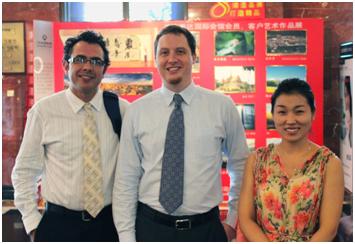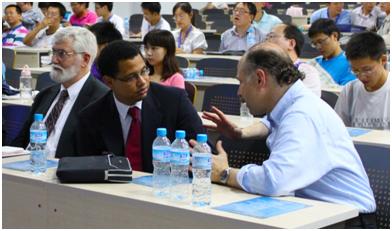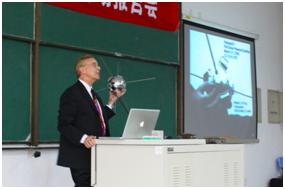博文
理文编辑出席中国物理学会2010年会AIP分会
||||
Hello,
For my first post, I would like to talk about our trip to Tianjin. We met with the heads of the publishing department from the American Institute of Physics (AIP). These events in Tianjin were part of the continuing commitment by AIP to research in China. AIP recently opened an office in Beijing, which is under the direction of Professor Ai. In addition, senior AIP publishing administrators, Dr. John Haynes, Dr. Mark Cassar, and Dr. Robert Harrington, have made multiple trips to China in recent months. China's research community now accounts for the second largest number of submissions to all AIP journals. Here is picture of my colleagues, Ben and Rachael, with Dr. Cassar, acting Publisher for AIP:
The first day of the trip focused on a workshop at Tianjin University, in which Professor Lam, Editor-in-Chief of Applied Physics Letters, and I presented advice to students on important aspect of scientific journal publication. AIP sponsored this event, and it was attended by over 70 students. Professor Ai organized the workshop.
I was very impressed with the quality of the students. They were a mix of undergraduate and graduate students. Many of the students had already submitted papers to journals, and a number of the students already had papers published. This was true of both the undergraduate and graduate students. To have undergraduate research of that calibre speaks to the high level of instruction at the university, because undergraduates with a publication record are rare at even at top universities in the United States and Europe.
This is a picture of me presenting at Tianjin University. The students asked some very acute questions, one of which I plan to dedicate an entire post. However, now I will just give an overview of the workshop. The workshop consisted of a talk followed by a mini-lesson with interactive exercises. The talk offered advice on every aspect of the publication process, including topics such as journal selection, manuscript writing, language editing, and dealing with reviewer comments. The mini-lesson following the talk involved actual excerpts from manuscripts. The short passages contained common language errors, which the student had to identify and offer suggestions on ways to correct them. The students showed a great eagerness to learn from the exercises and apply this new knowledge to their future work.
The next day was particularly exciting for me, because I had been invited to speak at the AIP session of the Chinese Physical Society's (CPS) Annual Conference at Nankai University. This session was organized by Professor Ai, and it was chaired by Dr. Haynes, Vice President for Publishing at AIP. It was not only a great honor to be asked to speak at the session, but I got to meet the other presenters in the session: Professor Lawrence Kazmerski, Executive Director for Photovoltaics at the National Renewable Energy Laboratory; Professor Xue Qi-Kin, Dean of the School of Sciences at Tsinghua University; Professor David Awschalom, from UC Santa Barbara; Professor Nghi Lam, who joined me at the Tianjin University Workshop; Dr. Stephen Benka, Editor-in-Chief of Physics Today. These presenters are all leaders in their fields, and I was pleased to be able to present along with them and talk to them about their current work. Here is a picture of me conversing with Professor Awschalom:
The talks were very engaging. Professor Xue gave and overview of the state of topological insulators, and the proceeded to present his group's work, which marked a great advancement in the field showing materials with band structures with clear topological-insulator characteristics.
Professor Kazmerski, known for a personality as colorful as his ties, gave us a history of photovoltaics. He told us a funny story about Vanguard, the first solar powered satellite. Apparently, the engineers who designed it did not think that the photovoltaic cells that powered it would work. To protect the project from failure, the satellite was initially powered by batteries and then the solar cells would take over once the batteries lost power. Unfortunately, the engineers did not make any means to turn the satellite off, and the solar cells exceeded expectations. The satellite, initially launched in 1958, interfered with a frequency band at 108.3 MHz until 1964, when solar flares finally destroyed its electronics. It is still in orbit and its orbit is not expected to decay for another 189 years.
Professor Awschalom, whose research I have followed in my own career, talked about using nitrogen centers in diamond as quantum systems. His group was able to turn an ordinary diamond into a light source, which had photon anti-bunching properties, using only a laser pointer to excite the nitrogen centers. Recently, his group developed a method for placing ordered nitrogen defects in synthetic diamond using ion-beam milling. At the end of his presentation, he gave us a preview of some of his group's current findings. I cannot share those with you now, but if you are interested in quantum communications keep an eye out for his group's upcoming publications.
Dr. Benka talked about his experience working as Editor-in-Chief of Physics Today (PT), which is AIP's flagship publication. PT only publishes about 40 articles per year, which is just over three articles per issue. It seeks to bring physics news to a large audience. Therefore the quality of the articles must be very high. The limited number of articles per issue helps maintain this quality standard. He expressed a great interest in reporting on Science here in China, and showed particular desire to learn more about Dome A and the new underground darkmatter research laboratory.
Professor Lam gave insights into the concerns of journal editors based on his tenure as Editor-in-Chief of APL. He presented statistics showing the recent growth in journal submissions driven primarily by the rapid expansion of basic research in China. This recent growth has led to a rejection rate exceeding 60%. More than half of these papers are rejected prior to the review process. This means that having submissions free of technical faults such as formatting and language errors is extremely important. At APL, Chinese authors account for the largest portion of submissions (22%), but Chinese authors only review 2.4% of the submissions to APL. To fix this, China must improve the culture surrounding peer review. Here is a picture of Professor Lam with Dr. Haynes during the question period after his talk:
I presented the final talk in the session. Professor Lam’s talk fit well with mine, because I gave the participants tips on how to write a good paper, which would be free of the technical and language errors that get manuscripts reject prior to the review process. In addition, I stressed the importance of interacting with the scientific community, by attending conferences such as this one, reading journals, and reviewing papers. Interacting with the community here on Sciencenet is another way engage with other scientists, so I invite you to share your thoughts about this and my future posts either through comments on this site or email: dbroaddus<at>edanzgroup.com
As a final note, both the slides from the Tianjin University workshop and the CPS talk are available on our company's website: www.liwenbianji.cn
All the best,
Daniel Broaddus
Senior Editor and Trainer, Liwen Bianji
https://m.sciencenet.cn/blog-288924-381696.html
上一篇:理文编辑新任高级编辑介绍
下一篇:Michal Lipson won a MacArthur “genius” grant




